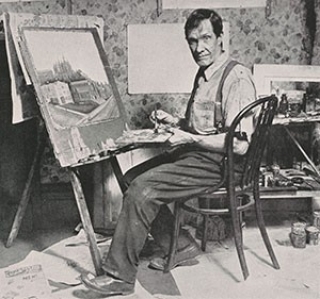Born 1860, West Calder, Scotland
Died 1934, Pittsburgh, Pennsylvania
In 1879 John Kane, who was born to Irish parents in Scotland, emigrated to the US , where he was employed in various forms of manual labor. After losing a leg in a train accident in 1891, he began painting boxcars, signs, houses, and eventually canvases. In 1927 his Scene from the Scottish Highlands was accepted by the jury for the annual international exhibition of the Carnegie Institute in Pittsburgh. Kane’s inclusion, despite his lack of formal training, was controversial, and the ensuing attention launched his artistic career. He became one of the most prominent self-taught artists of the period, with his paintings shown regularly in Pittsburgh as well as at MoMA and the Whitney Museum of American Art in New York, the Phillips Collection in Washington, DC, and the Barnes Foundation in Philadelphia. In 1938 MoMA featured Kane in Masters of Popular Painting and in a show sent to the Musée du Jeu de Paume in Paris as well as acquiring his work for its collection.
Kane painted urban scenes, pastoral vistas, portraits, and historical motifs. He often depicted highland scenes and the cultural festivals of the Scottish immigrant community in Pittsburgh. In addition, he celebrated his adopted country in paintings of the founding fathers and signal events in American history, such as the Gettysburg Address. But it was his landscapes that secured his reputation, attracting museums and collectors alike. The artist’s sturdy sense of composition and detailed eye have often been attributed to his firsthand knowledge of his subjects and his workmanlike ethos.
His iconic self-portrait of 1929 shows him posed in front of a mirror, under a trio of bold, curving lines. The frankness of the picture extends to both its subject and its technique: the artist depicts his steady gaze and bare, muscular torso in exacting detail. The same level of attention is brought to the solidified clouds and masses of tiny trees dotting the landscape of Through Coleman Hollow up the Allegheny Valley and the tartan patterns documented in his Scotch Day at Kennywood (1933). The underlying patriotic sentiment of On the Farm is materialized in the tribute to Abraham Lincoln on the verso of the painting.
Jenevive Nykolak
Arkus, Leon Anthony. John Kane, Painter. Pittsburgh: University of Pittsburgh Press, 1971.
